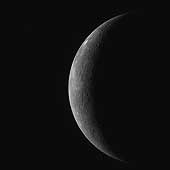|
COMETS EARTH JUPITER KUIPER BELT MARS MERCURY METEORITES NEPTUNE OORT CLOUD PLUTO SATURN SOLAR SYSTEM SPACE SUN URANUS VENUS ORDER PRINTS
PHOTO CATEGORIES SCIENCEVIEWS AMERICAN INDIAN AMPHIBIANS BIRDS BUGS FINE ART FOSSILS THE ISLANDS HISTORICAL PHOTOS MAMMALS OTHER PARKS PLANTS RELIGIOUS REPTILES SCIENCEVIEWS PRINTS
|
Related Documents
Download Options
Date Acquired: October 6, 2008 MESSENGER successfully flew by Mercury on October 6 2008, using Mercury's gravity to perturb the probe's path and to help put it on track to become, in March 2011, the first spacecraft ever to orbit the innermost planet in the Solar System. This image, acquired about 89 minutes before the craft's closest approach to Mercury, resembles the optical navigation images taken leading up to the flyby. The resolution of this image is slightly better than that obtained by the final optical navigation image set, and the surface visible is newly imaged terrain that was not previously seen by either Mariner 10 or during MESSENGER's first flyby. However, the added resolution is not the main scientific advancement that will be provided by this image. This WAC image is one of 11 viewed through different narrow-band color filters, the set of which will enable detailed color studies of this newly imaged area. In addition, the Narrow Angle Camera (NAC) acquired a high-resolution mosaic of most of this thin crescent view of Mercury at a resolution better than 0.5 kilometers/pixel (0.3 miles/pixel) that will enable the MESSENGER team to explore this newly imaged region of Mercury's surface in more detail. Images acquired during the flyby are currently still being transmitted to Earth, and the MESSENGER team is busy examining each of the 1223 as it arrives. When combined with the 64 optical navigation images previously obtained, MDIS acquired a total of 1287 images during the flyby encounter. Credit: NASA/Johns Hopkins University Applied Physics Laboratory/Carnegie Institution of Washington |
